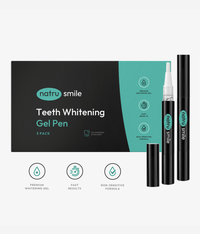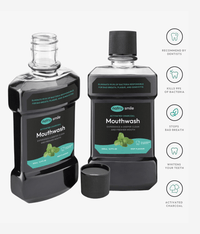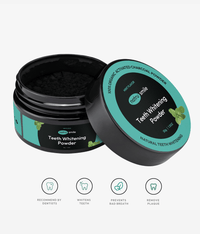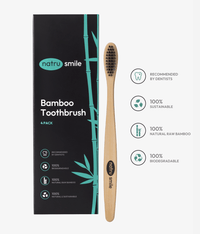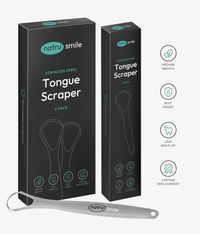
All products are certified by dental expert Dr. Greg Grillo
If you are in the process of getting a new dental crown or are considering one, you'll need to get a temporary crown at some point.
A temporary dental crown is a short-term version of a full ceramic or porcelain crown that your dentist can provide while you wait for your permanent replacement. It acts as an interim solution until the lab completes your final restoration.
To get the most out of your temporary crown, it's important to understand the process and what you can expect.
In this article, we'll tell you everything you need to know about temporary crowns and what they can do for you.
What Is A Temporary Crown? Overview
A temporary crown is a temporary tooth covering that is placed over a damaged or decayed tooth to protect it while a permanent crown is being prepared. They are typically made of acrylic or composite material and are designed to be worn for a short period, usually two to three weeks.
Temporary crowns serve several important purposes, including:
- Protecting the tooth: Temporary crowns are used to protect a tooth that has been damaged by decay or trauma. They help to prevent further damage and infection while a permanent crown is being fabricated.
- Maintaining tooth function: Temporary crowns help to preserve the function of the tooth while a permanent crown is being made. They allow patients to eat and speak normally while they wait for their permanent crowns, which can take a week or longer.
- Maintaining tooth structure: Temporary crowns keep your mouth aesthetically pleasing while you wait for a permanent crown. They also help to maintain the shape and structure of your tooth, which can help preserve its longevity.
Temporary crowns may not match your tooth color exactly, and they may not look exactly the way you want. If the tooth underneath your temporary crown is dying, the grey shade may shine through.
These issues are not the case with permanent crowns, which are specially designed with the proper crown color and are shaped to your mouth based on a mold.
When Do You Need A Temporary Crown?
There are several reasons a patient might need a temporary crown, mostly revolving around the need to wait for a permanent crown. These include:
- You are getting a full-coverage dental crown, and the laboratory has not yet provided your permanent crown
- You have an infection or decay that requires treatment before receiving a permanent crown
- Your dentist needs more time to assess the condition of your tooth before providing a permanent crown
- You are getting a dental bridge and need to wait for the lab to make the permanent bridge
There are many reasons patients find themselves in a position where they need a temporary dental crown installed, most of which precede permanent crown installation.
The most common are:
Severe Tooth Decay
If your tooth has a cavity, you will usually only need to get it filled. But if you have significant tooth decay, you'll either need dental onlays or crowns.
Onlays are primarily for teeth that have less decay, while crowns are best for teeth with more significant damage (i.e., tooth enamel loss around the edges of the tooth).
Trauma
If your tooth has been damaged due to trauma, such as an accident or sports injury, you may need a crown to restore it. Crowns can help protect the broken tooth while it heals, as well as preserve its function and appearance.
If you have broken a tooth to the point where your root is preserved, a crown also protects the rest of the tooth from becoming infected or dying.
Chipped Or Cracked Teeth
A crown can help protect and strengthen damaged or chipped teeth. It can also help maintain the shape of your tooth.
In the case of cracked or chipped teeth, you will usually choose between dental crowns and veneers. But veneers are only an option if the damage is minor.
"Long-Term" Replacement
If you are not an adult, your teeth aren't finished moving around in your mouth. When young children and teens break or damage their teeth, they might not be candidates for a permanent just yet.
Temporary crowns will occasionally break, but they offer a cost-effective and easily removable solution for children and young adults who would face significant aesthetic issues without a tooth and functional problems with a permanent one.
What Are Temporary Crowns Made Of?
Temporary crowns are typically made of materials that are designed to be strong and durable enough to protect the tooth while the permanent crown is being made.
The materials used for temporary crowns can vary depending on the dentist's preference and the patient's needs, but here are some of the most common materials:
- Acrylic: Acrylic is a common material used for temporary crowns because it is strong, durable, and easy to shape. It is also lightweight and comfortable for the patient to wear.
- Stainless steel (metal crowns): Stainless steel is another common material used for temporary crowns, especially for children's teeth. It is very strong and durable and can withstand the wear and tear of chewing and biting. Just like gold tooth crowns, they are easy to remove and clean and best suited for back teeth.
- Composite resin: Composite resin is a tooth-colored material that can be used for temporary crowns. It is easy to shape and can be color-matched to the patient's natural teeth.
- Polycarbonate: Polycarbonate is a plastic material used for temporary crowns. It is made with microglass fibers to help strengthen it and make it durable. It is also easy to shape and color-match, making it ideal for front teeth where aesthetics are important.
- Zinc oxide eugenol: This material is used for temporary crowns because it has some antimicrobial properties that can help prevent infection. It is also easy to shape and can be used for various dental restorations.
How Long Do You Keep A Temporary Crown?
As the name suggests, temporary crowns are meant to last only a few weeks. The length of time that a temporary crown is kept in place can vary depending on several factors, including the reason for the crown and the individual patient's circumstances.
Here are some general guidelines for how long a temporary crown is kept in place:
- After a root canal: Temporary crowns are usually worn for two to three weeks after a root canal, while waiting for the permanent crown to be fabricated.
- For a broken or decayed tooth: Temporary crowns may be worn for a few weeks to several months, depending on the extent of the damage and how long it takes to prepare the permanent crown.
- For a dental implant: Temporary crowns may be worn for several months as the implant heals and integrates with the surrounding bone tissue.
In some cases, a temporary crown may need to be replaced if it becomes loose or falls off. Patients should contact their dentist if they experience any issues with their temporary crown.
Caring For A Temporary Crown
Although temporary crowns aren't meant to be a long-term solution, it is essential to care for them properly to ensure their longevity.
Here are a few tips:
Avoid Hard Or Sticky Foods.
Most of the foods and drinks that damage teeth should be avoided when wearing a temporary dental crown. Temporary crowns are durable, but they are in no way meant to withstand foods that are tough, chewy, or crunchy.
Here are some examples of foods to avoid:
- Carrots and other hard vegetables
- Fruits that require you to bite into them (e.g., apples, pears)
- Chewy candies
- Granola bars and other crunchy snacks
- Bread-based foods that require big bites, such as sandwiches and hamburgers
In general, anything that requires you to bite with your front teeth should be limited. Opt for foods you can eat with a fork and knife.
Stay Away From Hot And Cold Liquids.
If you have pain or sensitivity around your crown, avoid hot and cold liquids. Since the seal on a temporary crown isn't as secure as that of a permanent one, hot and cold liquids can cause the crown to come loose or even fall off.
If you want to avoid some of the sensitivity while still enjoying your favorite beverages, you can try using a straw.
Be Gentle When Brushing And Flossing.
If you brush too hard around your temporary crown, you risk damaging it or loosening the adhesive. And if you need to wear your crown for more than a few weeks, you want to protect your gums from receding. Gum recession can cause bacteria to form underneath your crown, which your toothbrush can't reach.
Flossing too hard can dislodge the temporary crown, so be sure to use a flosser or threader and approach your teeth gently.
Quit Smoking And Vaping.
Although you have a temporary crown, it is still important to stay away from any habits or activities that could damage your oral health.
Vaping has significant impacts on your oral health, as does smoking. Smoking and vaping can cause staining, discoloration, bad breath, gum disease, and other issues that could affect your temporary crown.
Stop Playing Contact Sports.
If you play contact sports like football or hockey, you should consider ditching them while you have your temporary crown in place. While the material used to make a temporary crown is sturdy, it is not designed to withstand hard impacts and could break if hit with a ball or another player's body. Furthermore, you risk doing further damage to your teeth, messing up your prognosis.
Keep Your Follow-Up Appointments.
The most critical thing you can do (or not do) while you wear a temporary crown is to keep all scheduled follow-up appointments.
Your dentist will need to check the crown periodically to make sure it fits properly and isn't causing you any discomfort.
They may also want to take new x-rays or other images of your teeth, which can help them plan for your permanent crown and prevent any further damage.
Temporary Crown Vs. Permanent Crown
Temporary crowns and permanent crowns are both used to restore damaged, decayed, or discolored teeth, but they differ in their materials, durability, and longevity.
Here are some key differences between temporary crowns and permanent crowns:
- Material: Temporary crowns are typically made of acrylic or stainless steel, while permanent crowns are usually made of materials like zirconia, porcelain, or ceramic. They are also reinforced with a metal alloy underneath.
- Durability: Temporary crowns are designed to be a temporary solution and are not as durable as permanent crowns. They are more susceptible to wear and tear, and may chip or break more easily.
- Longevity: Temporary crowns are designed to be worn for a short period of time, usually two to three weeks. Permanent crowns, on the other hand, are designed to last for many years, typically 10 to 15 years or more.
- Fabrication: Temporary crowns are typically made in the dentist's office, while permanent crowns are fabricated in a dental laboratory. Permanent crowns are custom-made to fit the patient's tooth precisely, using computer-aided design and manufacturing (CAD/CAM) technology.
Temporary Crown Cost
The cost of dental crowns is significant, multifaceted, and varied based on your personal situation and prognosis. Temporary crowns are one element of the total dental drown cost, and these can range from a few hundred dollars to over a thousand, depending on the complexity.
Some dentists include the price of the temporary crown on one final bill, while others will charge for it separately. And if you need to replace your crown, you can expect to pay additional fees for the new materials.
Want to learn more? Here are the questions our customers ask us the most.
Should A Temporary Crown Hurt?
If your crown placement requires your dentist to shave off too much of your tooth, it can cause pain and irritation. Other than that, a temporary crown should not hurt. Some mild sensitivity or discomfort is normal immediately after the placement, but it should subside within a few days.
Does A Temporary Crown Cause Sensitivity?
It is possible to experience sensitivity with a temporary crown, especially to hot or cold temperatures. Since temporary crowns aren't as tightly attached to your teeth, there is a chance that debris, hot and cold liquids, or air can get between the crown and your tooth. This can cause sensitivity.
Should I Brush Over My Temporary Crown?
Yes, it is important to brush teeth just as you normally would, even over your temporary crown. If you do not brush your teeth over your crown, you run the risk of developing plaque and food debris buildup, which can cause more serious oral health issues like cavities or gum disease.
Can I Eat With A Temporary Crown?
Yes, you can eat food while wearing your temporary crown. However, it is best to stick to soft foods and avoid anything that requires excessive chewing, such as tough meats or crunchy snacks like popcorn. Since temporary crowns are made of materials like acrylic or composite, chewing with too much force or eating foods that are too tough can cause them to dislodge or break.
How Long Can You Have A Temporary Crown After A Root Canal?
Typically, a temporary crown is worn for two to three weeks after a root canal. This allows time for the permanent crown to be fabricated. In some cases, a temporary crown can be worn up to six months. However, that should only be done if the permanent crown cannot be placed right away.
What Should I Eat With A Temporary Crown?
It is best to avoid hard, sticky, or chewy foods with a temporary crown. Here is a list of foods that are safe to eat with a temporary crown:
- Soft fruits and vegetables like applesauce, squash, pears, and bananas
- Soups and stews
- Cooked grains like oatmeal or quinoa
- Dairy products like yogurt, milk, or cottage cheese
- Soft proteins like eggs or fish
- Pudding or fruit smoothies
- Soft breads and pastas like bagels, pasta salad, mashed potatoes, or macaroni and cheese
What Should I Do If My Temporary Crown Comes Off?
If your temporary crown comes off, try to save it if possible and contact your dentist right away. Avoid chewing on that side of your mouth until the crown can be replaced. In the meantime, you can use dental wax to cover any exposed tooth surface and protect it from further damage.
How Long Are Gums Sore After A Temporary crown?
It is normal to experience some gum soreness and tenderness for a few days after getting a temporary crown. After the procedure, your gums may be swollen from the mildly invasive nature of the procedure. And placing new material on your tooth will likely cause some sensitivity. Any soreness and tenderness should subside within a few days.
What Should I Do If My Temporary Crown Breaks?
If your temporary crown breaks or comes off, contact your dentist as soon as possible. Often, they will be able to take you in for an "emergency" appointment to either fix or replace the crown. The appointment shouldn't take long, as the groundwork for the crown has already been done. If you cannot get in to see your dentist right away, use dental wax to cover any exposed tooth surface and protect it from further damage.
How Long Can You Go Without A Temporary Crown?
It is best to have a temporary crown replaced as soon as possible to avoid further damage to the tooth or potential infection. However, if necessary, a temporary crown can be worn for a few days without causing significant harm. After a few days, the risk of infection and other complications increases.
Can You Smoke With A Temporary Crown?
It is best to avoid smoking altogether, especially if you have partially exposed tooth surfaces. Not only can smoking irritate the gums and increase your risk of infection, but it can also stain or discolor your temporary crown. If you do decide to smoke while wearing a temporary crown, make sure to brush your teeth afterward to remove some of the residue or tar buildup that may have occurred.
How Long Can You Have A Temporary Crown?
Typically, a temporary crown is worn for two to three weeks while waiting for the permanent crown to be fabricated. However, some patients find that their temporary crown is sufficient to last for years with minimal maintenance.
Is It Dangerous To Swallow A Temporary Crown?
Swallowing a temporary crown is not dangerous, as it will pass through your system harmlessly. But you will need to contact your dentist for a new one. Otherwise, you'll be at risk of further damage to your tooth or potential infection.
Can You Floss A Temporary Crown?
You can and should floss around a temporary crown. Flossing helps to remove food debris and plaque buildup that can lead to dental decay. Make sure to be gentle when flossing, as being too rough may cause the temporary crown to come off or break.
Can You Vape After Getting A Temporary Crown?
As is true with smoking and using tobacco products, it is best to avoid vaping after getting a temporary crown, as vaping can increase the risk of infection and delay the healing process. Vaping is also harmful to your oral health in other ways, as the chemicals and particles can lead to gum disease and discoloration of your temporary crown.
Are There Any Foods I Should Avoid When Wearing A Temporary Crown?
It is best to avoid hard or sticky foods while wearing a temporary crown. Hard foods like nuts can damage the temporary material, while sticky foods like caramel or taffy can pull at your crown and dislodge it over time.
Is It Possible To Remove A Temporary Crown At Home?
You should never attempt to remove a temporary crown at home. Not only is it difficult to do so without the help of specialized tools, but it can also cause severe damage to your tooth and gums if done improperly. Even if it looks straightforward, you should never attempt this on your own.
Does A Temporary Crown Cover The Whole Tooth?
A temporary crown covers the entire visible portion of the tooth and should line up with your gumline. However, temporary crowns are engineered to cover the tooth without extending over the edges, as this can increase your risk of infection or discomfort.
Can A Temporary Crown Dissolve?
Temporary crowns are made of durable composite material and designed to last several weeks. However, they are not immune to damage and can become cracked or chipped over time. If this happens, the crown needs replacing to protect your tooth from further damage.
Is A Permanent Crown Stronger Than A Temporary Crown?
Yes, a permanent crown is stronger than a temporary crown. Permanent crowns are fabricated from stronger and more durable materials, and they are designed to last for many years. Temporary crowns, while designed to be sturdy and durable, are not as strong and may need replacing after a few weeks.


